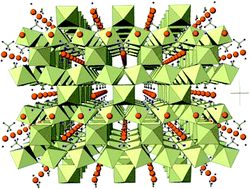Antimonic acid Sb2O5·4H2O with the pyrochlore structure is a well known ion-exchanger that is selective for Sr2+ in mildly acidic solution. An enhancement of the ion exchange properties of antimony-based pyrochlore materials, with respect to Cs+ and Sr2+, was previously reported by Möller and co-workers to be achievable if Si4+ is incorporated during synthesis of these materials (T. Möller, R. Harjula, M. Pillinger, A. Dyer, J. Newton, E. Tusa, S. Amin, M. Webb and A. Araya, J. Mater. Chem., 2001, 11, 1526–1532). The present study aims to shed light on the role of Si4+ in the pyrochlore structure and its influence on the ion-exchange properties. A series of samples were prepared with increasing concentrations of Si added during preparation. X-Ray powder diffraction and electron microscope observations indicate that the average particle size of the antimony pyrochlores decreases as Si concentration increases. Refinement of X-ray powder data shows a small and abrupt decrease in unit cell volume at an added Si concentration corresponding to about 10 atom%. For undoped samples 29Si solid-state MAS NMR showed only a single sharp resonance at −75 ppm assigned to Si(OH)4 species located within the hexagonal channels of the pyrochlore structure. The increasing addition of Si to the reactant mixture gave rise to a progressive increase in the intensity of resonances from hydrated amorphous silicate species. Base treatment succeeded in removing only the resonances due to these silicate species, leaving the resonance assigned to structural Si unaffected. These data are taken as confirmation of the assignment of the sharp −75 ppm resonance to isolated species Si(OH)4 within the pyrochlore tunnels. Neutron powder diffraction of partially dehydrated samples shows the existence of two pyrochlore phases that appear to differ slightly in their unit cell parameters and confirms that incorporation of Si4+ into the pyrochlore structure and a reduction in water content cause volume contraction of the cubic cell. The slight unit cell contraction resulting from Si incorporation is hypothesised to be responsible for enhanced Cs+ selectivity of samples containing Si.

You have access to this article
 Please wait while we load your content...
Something went wrong. Try again?
Please wait while we load your content...
Something went wrong. Try again?


 Please wait while we load your content...
Please wait while we load your content...